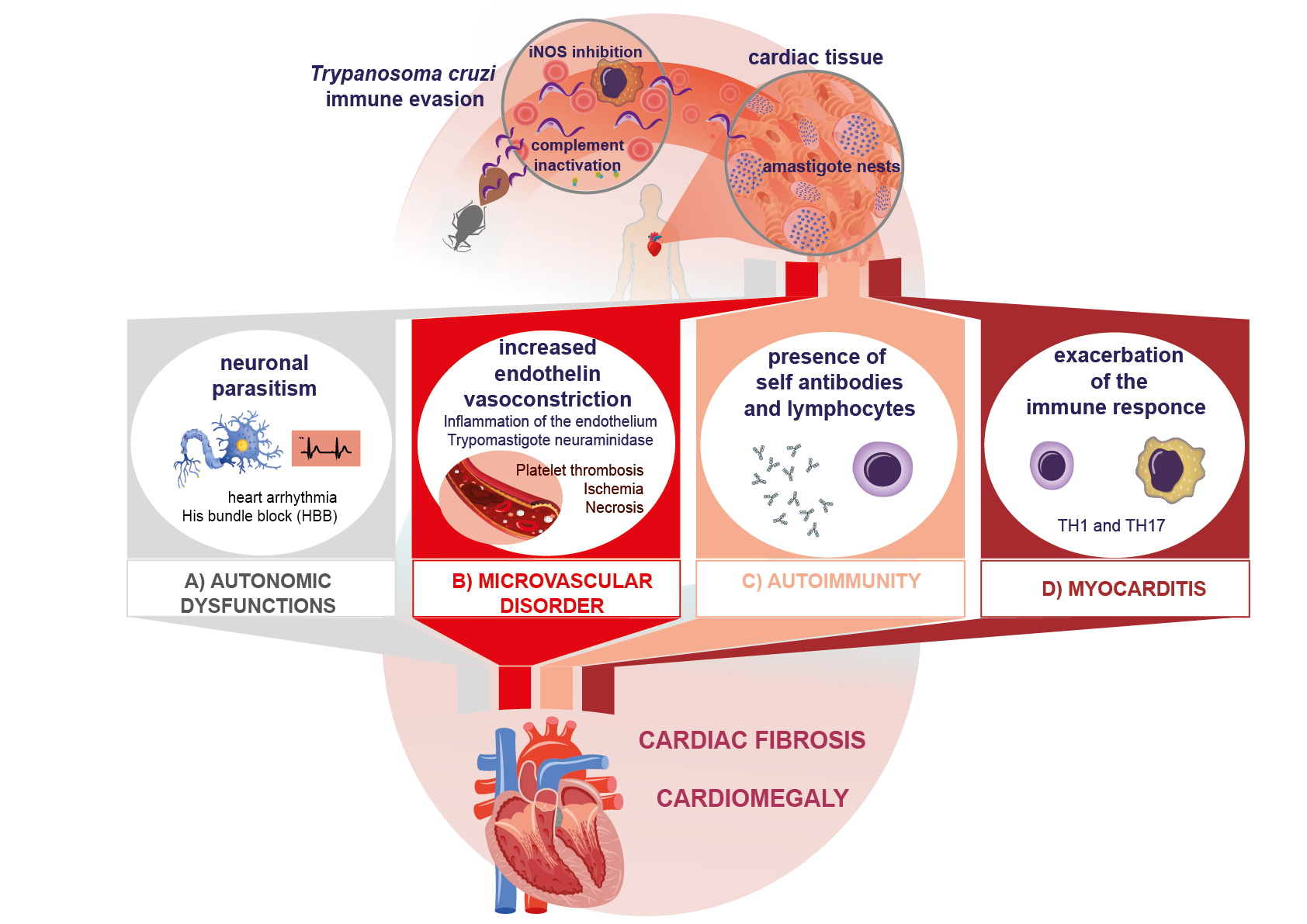Chagas disease is a complex zoonosis. Its natural history involves the interaction of transmitting arthropods with wild, peridomestic, and domestic mammals, and it has a great diversity of transmission forms. In a vertebrate host, the disease has two clinical phases: an acute phase and a chronic one; the former evolves without demonstrated pathology and can last 10–20 years. After this phase, some patients progress to the chronic symptomatic phase, in which they develop mainly cardiac lesions. The lesions in this cardiomyopathy involve several cardiac tissues, mainly the myocardium, and in severe cases, the endocardium pericardium; this can cause pleural effusion, which may evolve into sudden death, which is more frequent in cases with dilated heart disease and severe heart failure.
- immunopathology
- zoonotic disease
- Trypanosoma cruzi
- Chagas disease
1. Introduction
2. Pathogenic Mechanisms of Immune Response Evasion in Chagas Disease
Most of the mechanisms involved in evading the immune response occur in the acute phase, when trypomastigotes establish contact with immune cells of the vertebrate host. The parasite has evolved mechanisms to survive processes such as phagocytosis and the complement system, in addition to interfering with lymphocyte maturation. When metacyclic trypomastigotes contact host cells, either through skin lesions or mucous membranes, the immune response is activated. T. cruzi enters cells through two main mechanisms. The first one is lysosome-dependent, which favors Ca2+ mobilization [18]. In this stage, the parasite surface glycoprotein gp82 is crucial for cell adhesion and lysosomal fusion at the site of entry. Cruzipain has also been proven to be critical for calcium induction and lysosome recruitment. It is a cysteine-protease secreted by trypomastigotes [19,20]. The second mechanism involves invagination of the plasma membrane followed by lysosomal fusion. The acidification process of lysosomes containing the parasite is key to its differentiation into an amastigote, which is the replicative form. A disruption of cytoskeletal actin facilitates the mobilization of lysosomes towards the cell periphery, where they will fuse with the cytoplasmic membrane and contribute to the formation of a parasitic vacuole [21]. After several divisions in the parasitophorous vacuole, where sialic acid residues are added on the T. cruzi membrane by parasitic trans-sialidases, the phagolysosome is lysed. Thus, trypomastigotes are released into the cytoplasm and bloodstream to infect distant or adjacent tissues and cells [22]. Notably, factors such as strain, the level of antioxidant enzyme expression, and the kinetics of association with the phagolysosome may in turn contribute to parasite evasion and persistence in the host. In contrast to other protozoa, which inhibit phagolysosome maturation, T. cruzi evade macrophage activity by the mechanisms mentioned above, and escape from the phagolysosome into the host cell cytoplasm, where they replicate [29]. The complement system features a specialized pathway for mannose recognition in pathogenic organisms, and it is known that blood trypomastigotes activate this system; however, the parasite expresses a set of specific surface proteins for complement evasion [30,31]. T. cruzi trans-sialidases are crucial for host cell infection by transferring sialic acid from mammalian cells to their own glycocalyx [32]. Their presence is also known to reduce the recognition of anti-α-Gal antibodies in the bloodstream, in addition to evading the lytic effect of complement by promoting the conversion of C3 to inactive C3b (iC3b) [33]. T. cruzi calreticulin (TcCRT) is also involved in the evasion of the lectin pathway by binding to MBL or inhibiting the classical complement pathway by binding to C1q. These links inactivate the membrane attack complex (MAC) formation pathway [34]. Another mechanism by which the parasite controls the complement pathway is mediated by the CRP protein, which is anchored to the parasite membrane. This 160-kDa glycoprotein binds non-covalently to C3b and C4b to inhibit the assembly of C3 convertase, rendering it inactive to catalyze the cleavage of the complement system on the parasite surface. Another parasitic protein called T-DAF accelerates the decay of C3 and C5 convertase in the classical and alternative pathways of the complement system. [35].3. Histopathological Mechanisms Related to Tissue Parasitism
The presence and replication by binary fission of intracellular amastigotes in the myocardiocyte and its ensuing lysis cause inflammation, the release of cellular components, and finally the destruction of cardiac tissue [36]. A direct correlation between the presence of the parasite and tissue inflammation has been reported [37], even when only the presence of T. cruzi antigens or DNA has been confirmed in chronic lesions [38]. The infection can affect skeletal, cardiac, and smooth muscle, as well as neuronal tissue. Parasitism in the myocardium causes destruction and fibrosis in the Schwann sheath and nerve fibers, which leads to neurogenic alterations, clinically expressed as arrhythmias, His bundle branch block, and even the presence of dyssynergic areas in the parietal function of the heart (Figure 1A). All of these are characteristic manifestations of the chronic phase of Chagas disease [39,40]. Another important mechanism described in myocardial injury is the occurrence of microvascular abnormalities caused by the increase in endothelin due to inflammation. On the other hand, blood trypomastigotes have been described to produce neuraminidase (Figure 1B). All these mechanisms increase platelet adhesiveness and thrombus formation, leading to myocardial ischemia and microinfarcts, which in turn cause tissue necrosis [41,42].
